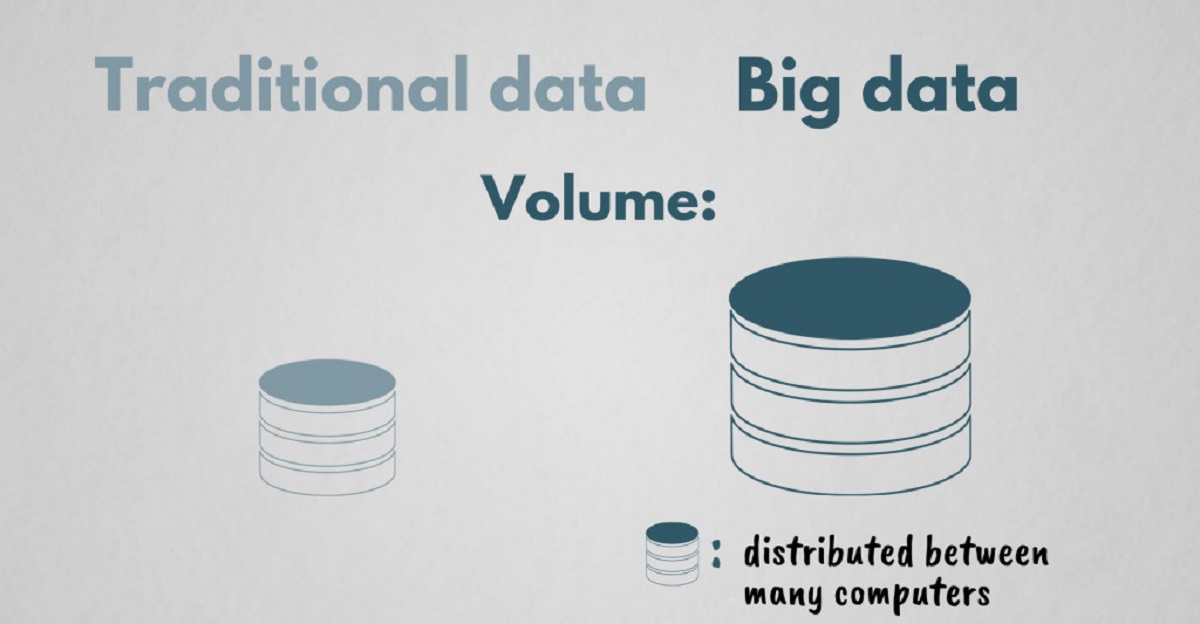Introduction
In today’s digital age, organizations are generating and capturing vast amounts of data at an unprecedented rate. This data, known as big data, holds valuable insights that can drive business growth, enhance customer experiences, and improve operational efficiency. However, effectively managing and harnessing the power of big data poses significant challenges for traditional relational databases.
Relational databases, while efficient for structured data, struggle to handle the volume, velocity, and variety of big data. As a result, many organizations are turning to NoSQL databases as a viable alternative to overcome these limitations. NoSQL, which stands for “not only SQL,” refers to a category of database management systems that provide flexible and scalable solutions for managing big data.
This article explores why organizations are embracing NoSQL databases to manage big data. It highlights the challenges of traditional relational databases, delves into the features and advantages of NoSQL databases, and discusses real-world use cases. By the end, readers will have a clear understanding of why NoSQL databases have become the go-to solution for managing big data.
What is Big Data
Big data refers to the enormous volume of structured, semi-structured, and unstructured data that organizations collect on a daily basis. This data comes from various sources such as social media, websites, sensors, transactions, and more. It is characterized by the three V’s: volume, velocity, and variety.
Volume: Big data is characterized by its sheer volume. Traditional databases are not equipped to handle the massive amounts of data generated by organizations. For example, social media platforms generate millions of posts, comments, and likes every minute. E-commerce websites track thousands of transactions daily. All of this data needs to be stored, processed, and analyzed efficiently to derive valuable insights.
Velocity: Big data is generated at an incredibly fast pace. The speed at which data is being produced requires real-time or near real-time processing to effectively utilize it. Traditional relational databases often struggle to keep up with the high velocity of data ingestion, leading to delays in data processing and analysis. This delay can hinder organizations from making timely and informed decisions based on the data.
Variety: Big data comes in various forms, including structured, semi-structured, and unstructured data. Structured data is organized and labeled, such as data stored in a spreadsheet or relational database. Semi-structured data has some organization but lacks a formal structure, like XML or JSON files. Unstructured data, on the other hand, lacks any organization or structure and includes data from social media posts, images, videos, and text documents. Managing and analyzing such diverse data types is a significant challenge for traditional relational databases.
In order to make sense of big data, organizations need robust database management systems that can handle its volume, velocity, and variety. This is where NoSQL databases offer valuable solutions. In the following sections, we will explore the limitations of traditional relational databases in managing big data and how NoSQL databases provide a more flexible and scalable approach.
Challenges of Managing Big Data
Managing big data poses several challenges for organizations, particularly when using traditional relational databases. These challenges arise due to the inherent limitations of relational databases in handling the volume, velocity, and variety of big data. Here are some of the key challenges faced when managing big data:
- Scalability: Traditional relational databases are designed to handle a moderate amount of data. However, as the volume of data grows exponentially, these databases struggle to scale horizontally. Scaling a relational database typically involves adding more powerful hardware or vertical scaling, which can be expensive and may not provide the required performance gains.
- Performance: Big data typically requires real-time or near real-time processing to derive timely insights. Traditional relational databases often have slower response times when dealing with complex queries or large amounts of data. This can result in delays in data processing and analysis, hampering organizations from making immediate business decisions.
- Data Variety: Big data comes in various forms, including structured, semi-structured, and unstructured data. Traditional relational databases are designed for structured data, which makes it challenging to efficiently store and analyze diverse data types. This limits the ability of organizations to gain comprehensive insights from their big data.
- Data Integration: Organizations may need to integrate data from multiple sources to obtain a holistic view of their big data. The integration process can be complex and time-consuming when using relational databases, as they require predefined schemas and data normalization. This makes it difficult to capture the full potential of big data in a timely manner.
- Data Loss: Relational databases typically use ACID (Atomicity, Consistency, Isolation, Durability) properties to ensure data integrity. However, when dealing with big data, enforcing strict ACID properties can lead to performance degradation. As a result, organizations may sacrifice data consistency and durability, increasing the risk of data loss or inconsistency.
These challenges highlight the need for a more flexible and scalable solution to effectively manage big data. NoSQL databases address these limitations by providing a schema-less design, distributed architecture, and horizontal scalability. In the next section, we will explore how NoSQL databases overcome these challenges, making them an ideal choice for managing big data.
Traditional Relational Databases and Their Limitations
Traditional relational databases have been the primary choice for data storage and management for decades. They are well-suited for structured data, offering robust data integrity, transactional support, and a well-defined schema. However, when it comes to managing big data, relational databases face several limitations that hinder their effectiveness. Let’s explore some of these limitations:
- Scalability: Relational databases are designed for vertical scalability, meaning that they rely on powerful hardware to handle large workloads. However, scaling vertically has its limitations, and there is a threshold beyond which further scalability becomes impractical and expensive. This makes it challenging for relational databases to handle the enormous volume of data generated by big data applications.
- Schema Rigidity: Relational databases require a predefined schema, which defines the structure and relationships of the data. This schema must be defined upfront and followed strictly, making it difficult to accommodate changes in data structure or handle unstructured or semi-structured data. This rigidity restricts the flexibility needed to effectively manage and analyze the diverse data types associated with big data.
- Performance: Relational databases can experience performance degradation when working with complex queries or when handling massive datasets. Data normalization, indexing, and join operations can introduce bottlenecks and slow down data retrieval and processing. As big data requires real-time or near real-time analysis, the slower response times of relational databases can hinder timely insights.
- High Costs: Relational databases often require expensive hardware and software licenses to handle large-scale data processing. Additionally, scaling vertically can result in higher maintenance costs. For organizations dealing with big data, the cost of scaling and licensing can become prohibitive, making traditional relational databases less practical.
- Data Integration: When dealing with big data, organizations often need to integrate data from multiple sources to gain comprehensive insights. Relational databases have strict requirements for data normalization and predefined relationships, making data integration complex and time-consuming. This can delay the availability of integrated data, limiting the real-time decision-making capabilities of organizations.
These limitations of traditional relational databases have led organizations to explore alternative solutions to effectively manage and extract value from their big data. NoSQL databases offer a more flexible and scalable approach, addressing these limitations and providing better support for the unique characteristics of big data. In the following sections, we will delve into the features and advantages of NoSQL databases for managing big data.
What are NoSQL Databases
NoSQL databases, also known as “not only SQL” databases, are a category of database management systems that provide an alternative approach to traditional relational databases. These databases are designed to handle large volumes of diverse and unstructured data, making them an ideal choice for managing big data. Unlike relational databases, NoSQL databases offer a schema-less design and horizontal scalability.
The term “NoSQL” is often misunderstood as implying a lack of any structured query language. However, this is not the case. NoSQL databases do provide a query language, albeit with a different syntax and approach compared to SQL (Structured Query Language).
NoSQL databases can be categorized into various types, including:
- Document Databases: These databases store and manage semi-structured or unstructured data in the form of documents, such as JSON or XML. Each document can have a different structure, allowing flexibility in data representation. Document databases provide rich query capabilities, allowing for efficient retrieval and manipulation of data.
- Key-Value Databases: Key-value databases store data as a collection of key-value pairs. These databases excel at simple and fast data retrieval, making them a suitable choice for caching, session management, and handling high-traffic websites. Key-value databases offer minimal query capabilities beyond retrieving data based on keys.
- Columnar Databases: Columnar databases store data in columns rather than rows, making them efficient for analytical workloads that involve aggregations and complex queries. These databases are well-suited for data warehousing and large-scale analytics.
- Graph Databases: Graph databases store data in a graph-like structure, consisting of nodes (entities) and edges (relationships). These databases excel in managing complex relationships and are suitable for applications such as social networks, recommendation systems, and fraud detection.
NoSQL databases offer several advantages for managing big data compared to traditional relational databases. In the next section, we will explore the specific benefits and advantages that NoSQL databases bring to the table in the context of big data management.
Advantages of NoSQL Databases for Big Data Management
NoSQL databases provide numerous advantages that make them well-suited for managing big data. These advantages stem from their flexible schema design, distributed architecture, and scalability. Here are some of the key benefits of using NoSQL databases for big data management:
- Scalability and Performance: NoSQL databases are designed for horizontal scalability, allowing organizations to distribute their data across multiple servers, also known as a cluster. This distributed architecture enables the databases to handle large volumes of data and effortlessly scale as data grows. Additionally, NoSQL databases have high-performance capabilities, allowing for faster data ingestion, processing, and retrieval compared to traditional relational databases.
- Flexibility and Schema-less Design: NoSQL databases offer a flexible schema-less design, which means that data does not need to adhere to a predefined schema. This enables organizations to store and manage diverse data types, including structured, semi-structured, and unstructured data, without the need for extensive data modeling or schema changes. This flexibility makes it easier to work with big data, which often includes a variety of data formats and structures.
- Distributed and Fault-tolerant Architecture: NoSQL databases are designed for distributed systems, which means that data is replicated across multiple nodes in a cluster. This ensures high availability and fault tolerance, as the system can continue operating even if individual nodes fail. This distributed nature also allows for efficient data replication and synchronization, essential for big data scenarios where data needs to be processed and analyzed in real-time.
- Variety of Data Models: NoSQL databases offer various data models to suit different data requirements. Document databases enable storing and querying nested and complex data structures, columnar databases are effective for analytical workloads, key-value databases excel in simple data retrieval, and graph databases are ideal for managing highly connected data. This variety of data models allows organizations to choose the most appropriate model for their specific use cases and data types.
- Real-time Data Processing: NoSQL databases are optimized for real-time and near real-time data processing. They can handle high-velocity data streams, enabling organizations to analyze and respond to data in real-time. This is crucial for applications such as fraud detection, recommendation systems, and IoT analytics, where time-sensitive insights are required to drive immediate actions and decision-making.
These advantages make NoSQL databases a powerful choice for organizations managing big data. By leveraging the scalability, flexibility, and performance of NoSQL databases, organizations can unlock the full potential of their big data and derive valuable insights to drive growth, innovation, and competitive advantage.
Scalability and Performance
One of the key advantages of NoSQL databases for big data management is their scalability and performance. NoSQL databases are designed to handle the enormous volume of data generated by big data applications and provide efficient processing capabilities. Here’s a closer look at how NoSQL databases excel in scalability and performance:
- Horizontal Scalability: NoSQL databases are built with a distributed architecture, allowing organizations to scale horizontally by adding more servers or nodes to a cluster. This means that as data grows, the database can seamlessly expand to accommodate the increasing workload. Horizontal scalability enables organizations to handle the ever-growing volume of data associated with big data applications without the need for costly hardware upgrades or infrastructure changes.
- Data Sharding: NoSQL databases use a technique called data sharding, where data is partitioned and distributed across multiple nodes in the cluster. Each node is responsible for storing a portion of the data, allowing for parallel processing and improved performance. As a result, NoSQL databases can handle high-velocity data streams and perform data operations efficiently, enabling real-time or near real-time processing and analysis of big data.
- In-Memory Caching: Many NoSQL databases offer in-memory caching capabilities, allowing frequently accessed data to be stored in memory for faster retrieval. By keeping hot or popular data in memory, NoSQL databases reduce read/write latencies and improve overall application performance. In-memory caching is particularly beneficial for high-traffic applications or use cases that require real-time data access, such as personalization engines or recommendation systems.
- Optimized Data Models: NoSQL databases provide various data models, each tailored to specific data requirements. These optimized data models enable better performance in different scenarios. For instance, document databases leverage indexes and query optimizations to efficiently retrieve nested and complex data structures. Columnar databases excel at aggregations and analytical workloads by storing data in column-based storage formats. The ability to choose the most appropriate data model allows organizations to achieve optimal performance for their big data management needs.
- Parallel Processing: NoSQL databases are designed to handle data in a distributed manner, enabling parallel processing of queries and operations across multiple nodes. This parallelism allows for efficient utilization of resources and faster execution of complex queries or data manipulations. As a result, organizations can achieve high performance and reduce processing times, leading to faster insights and improved decision-making based on big data.
By leveraging the scalability and performance capabilities of NoSQL databases, organizations can handle the increasing volume and velocity of big data while maintaining fast and responsive data processing. These features enable real-time or near real-time analytics, allowing organizations to make immediate and data-driven decisions. The next section will explore the flexibility and schema-less design of NoSQL databases, further enhancing their suitability for managing big data.
Flexibility and Schema-less Design
A major advantage of NoSQL databases for big data management is their flexibility and schema-less design. Unlike traditional relational databases that require a predefined schema, NoSQL databases allow organizations to store and manage diverse data types without the need for strict data modeling or schema changes. Here’s how the flexibility and schema-less design of NoSQL databases benefit big data management:
- Dynamic Schema: NoSQL databases provide a dynamic schema, which means that data can be stored without a predefined structure. This flexibility allows organizations to handle unstructured and semi-structured data that is common in big data applications. With a dynamic schema, data can be ingested and stored as-is, eliminating the need for extensive data transformations or modifications.
- Agile Development: The flexible nature of NoSQL databases enables agile development practices. Since the schema does not need to be predefined, development teams can iterate and evolve the data model as the requirements evolve. This accelerates the development process and reduces the time spent on data modeling and schema changes, empowering organizations to quickly adapt to changing business needs.
- Data Variety: NoSQL databases are capable of handling diverse data types, including structured, semi-structured, and unstructured data. This makes them well-suited for big data applications that deal with a wide range of data formats, such as social media posts, sensor data, log files, and multimedia content. The ability to handle such data variety empowers organizations to gain deeper insights and unlock the value hidden within their big data.
- Schema Evolution: NoSQL databases allow for schema evolution, enabling organizations to add or modify data fields as needed over time. This makes it easier to adapt to changing data requirements without disrupting existing applications or data storage. It also simplifies integration with other systems and ensures compatibility with evolving business needs.
- Reduced Data Transformation: Traditional relational databases often require extensive data transformations to fit data into a predefined schema. This can be time-consuming and complex, especially when dealing with large and complex datasets. NoSQL databases eliminate the need for such transformations, reducing data preparation efforts and allowing organizations to focus more on data analysis and deriving meaningful insights from their big data.
The flexibility and schema-less design of NoSQL databases significantly simplify the process of managing and analyzing big data. Organizations can store and process diverse data types without the constraints of a rigid schema, enabling faster and more flexible data management. In the next section, we will explore the distributed and fault-tolerant architecture of NoSQL databases and its importance in big data management.
Distributed and Fault-tolerant Architecture
NoSQL databases are designed with a distributed and fault-tolerant architecture, making them highly reliable and resilient for managing big data. This architecture allows data to be distributed across multiple nodes or servers, ensuring high availability and minimizing the risk of data loss. Here’s how the distributed and fault-tolerant architecture of NoSQL databases benefits big data management:
- High Availability: NoSQL databases replicate data across multiple nodes, ensuring that data remains available even if individual nodes or servers fail. This redundancy guarantees continuous access to data, providing uninterrupted service and minimizing potential downtime. With high availability, organizations can confidently rely on NoSQL databases to handle critical big data workloads.
- Horizontal Scaling: NoSQL databases are built for horizontal scalability, allowing organizations to add more nodes to handle increasing data volumes and processing demands. This scalability feature enables NoSQL databases to effortlessly accommodate the ever-growing size of big data. By distributing the workload across multiple nodes, NoSQL databases can efficiently manage and process large amounts of data in parallel, resulting in improved performance and responsiveness.
- Data Replication: NoSQL databases replicate data across nodes, providing data redundancy and ensuring data integrity. This replication strategy can be configured to create multiple copies of data across different servers or even across multiple data centers. Data replication not only enhances fault tolerance but also improves data durability, making it highly resilient against hardware failures or disasters.
- Automatic Data Synchronization: The distributed architecture of NoSQL databases includes mechanisms for automatic data synchronization across nodes. This ensures that updates or modifications to the data are propagated to all replicas, maintaining data consistency. Automatic data synchronization guarantees that all nodes in the cluster have access to the most up-to-date and accurate data, irrespective of the node they are connected to.
- Load Balancing: NoSQL databases employ load balancing techniques to distribute incoming data requests evenly across the nodes in the cluster. By distributing the workload, load balancing optimizes resource utilization and prevents any single node from becoming overloaded. This ensures smooth and efficient processing of queries and data operations, improving overall system performance and responsiveness.
The distributed and fault-tolerant architecture of NoSQL databases provides organizations with a robust and reliable framework for managing big data. It ensures high availability, scalability, and data integrity, even in the face of hardware failures or other disruptions. This architecture is essential for supporting real-time data processing, providing organizations with timely insights and actionable intelligence from their big data.
Variety of Data Models
NoSQL databases offer a variety of data models to cater to different types of data and diverse use cases. This flexibility in data modeling makes NoSQL databases well-suited for managing big data, which often involves handling various data formats and structures. Here’s a closer look at the different data models available in NoSQL databases and their benefits for big data management:
- Document Databases: Document databases store data in flexible, self-describing document formats like JSON or XML. They allow for the storage of semi-structured and unstructured data, such as social media posts, blog entries, or product catalogs. The key advantage of document databases is their ability to handle nested and complex data structures. This makes them well-suited for scenarios that involve flexible schemas and dynamic or evolving data.
- Key-Value Databases: Key-value databases store data as a collection of key-value pairs. They are simple and efficient, offering lightning-fast data access by leveraging the unique key to retrieve values. Key-value databases are particularly useful for applications that require high-speed data lookup or caching, such as session management or content delivery networks (CDNs).
- Columnar Databases: Columnar databases organize data into columns, rather than rows, allowing for efficient data compression and optimized analytical queries. They excel at handling large-scale analytics and workloads that involve aggregations or complex queries across a subset of columns. Columnar databases are commonly used in data warehousing, business intelligence, and decision support systems.
- Graph Databases: Graph databases store data in nodes and edges, representing entities and their relationships. They are designed to efficiently manage highly connected data, making them ideal for applications such as social networks, recommendation systems, fraud detection, and network analysis. Graph databases allow for efficient traversal and querying of complex relationships, enabling powerful insights from interconnected data.
The variety of data models offered by NoSQL databases allows organizations to choose the best fit for their specific use cases and data requirements. Different data models excel in different scenarios, enabling efficient storage, retrieval, and analysis of big data. This flexibility in data modeling empowers organizations to derive meaningful insights and valuable knowledge from their diverse big data sources.
Moreover, NoSQL databases often provide the ability to combine or mix data models, allowing organizations to leverage multiple models within the same database. This versatility further enhances the capabilities of NoSQL databases for managing big data and enables rich and complex data management scenarios.
Real-time Data Processing
Real-time data processing is a critical requirement for many big data applications, enabling organizations to derive immediate insights and take timely actions based on the ever-changing data landscape. NoSQL databases excel in real-time data processing, providing the speed and capabilities necessary to handle high-velocity data streams. Here’s how NoSQL databases support real-time data processing for effective big data management:
- Data Ingestion: NoSQL databases are optimized for high-speed data ingestion. They can handle the rapid intake of data from various sources, such as sensors, logs, social media feeds, or transactional systems. This agility allows organizations to capture vast amounts of data in real-time, ensuring that the most recent information is available for immediate analysis and decision-making.
- Near Real-time Analytics: NoSQL databases enable near real-time analytics by providing efficient and fast query processing. They support complex queries on large datasets, allowing organizations to gain insights from big data without significant delays. Near real-time analytics empower organizations to proactively respond, detect anomalies, or identify trends as they occur, enhancing operational efficiency and decision-making capabilities.
- In-Database Analytics: NoSQL databases often provide in-database analytics capabilities or seamless integrations with external analytics tools. This allows organizations to perform complex calculations, aggregations, and machine learning algorithms directly within the database, eliminating the need to transfer large volumes of data to separate analytics platforms. In-database analytics enable real-time analysis and streamlined workflows for big data applications.
- Real-time Stream Processing: Many NoSQL databases integrate with real-time stream processing frameworks, such as Apache Kafka or Apache Flink. These frameworks enable organizations to process and analyze streaming data in real time as it flows through the system. By combining the scalability and performance of NoSQL databases with real-time stream processing, organizations can handle vast data streams and derive immediate value from continuously arriving data.
- Low Latency: NoSQL databases are designed for low-latency data access and processing. The distributed and parallel architecture of NoSQL databases, along with optimized data models, results in reduced response times and high throughput. This low-latency capability is critical for real-time data processing, allowing organizations to make instant decisions and deliver real-time insights to stakeholders or end-users.
NoSQL databases’ support for real-time data processing enables organizations to harness the power of big data in time-sensitive scenarios. Whether it’s monitoring real-time customer interactions, analyzing machine data, or detecting anomalies in data streams, the ability to process and analyze data in real time empowers organizations to respond quickly, gain a competitive edge, and capitalize on emerging opportunities in today’s fast-paced business environment.
Use Cases of NoSQL Databases in Managing Big Data
NoSQL databases have become a popular choice for managing big data across various industries and use cases. Their flexibility, scalability, and real-time processing capabilities make them well-suited for handling the challenges and requirements of big data applications. Let’s explore some of the use cases where NoSQL databases shine in managing big data:
- Real-time Analytics and Personalization: NoSQL databases are used extensively in applications that require real-time data analysis and personalized experiences. For example, in e-commerce, NoSQL databases can store and analyze customer behavior, purchase history, and preferences in real time to deliver personalized product recommendations. NoSQL databases enable fast and scalable processing of large volumes of user data to provide immediate insights for decision-making.
- Internet of Things (IoT) Data Management: With the proliferation of IoT devices generating massive amounts of sensor data, NoSQL databases offer an ideal solution for IoT data management. These databases can handle the high velocity and variety of sensor data, enabling real-time insights and analytics. NoSQL databases provide the agility to ingest, store, and distribute IoT data across multiple nodes, ensuring scalability and fault tolerance for IoT applications.
- Social Media Analytics: Social media platforms generate enormous volumes of unstructured data in the form of posts, comments, likes, and shares. NoSQL databases can efficiently capture and process this data, enabling organizations to perform sentiment analysis, social network analysis, and trend detection in real time. These databases empower organizations to extract actionable insights from social media data for marketing campaigns, brand management, and customer sentiment analysis.
- Log Analysis and Operational Intelligence: NoSQL databases are instrumental in log analysis and operational intelligence use cases. By storing and analyzing logs from various systems, organizations can gain insights into system performance, identify anomalies, and detect security breaches in real time. NoSQL databases provide the scalability and speed required to process large log data volumes and perform complex queries to drive proactive monitoring and maintenance.
- Fraud Detection and Risk Management: NoSQL databases play a crucial role in fraud detection and risk management, particularly in financial services. By leveraging the real-time data processing capabilities of NoSQL databases, organizations can analyze large and diverse datasets to detect anomalies, patterns, and suspicious activities. NoSQL databases enable fast and accurate identification of fraudulent transactions or behaviors, reducing financial losses and mitigating risks.
These are just a few examples of how NoSQL databases are leveraged in managing big data across different industries. NoSQL databases offer the flexibility, scalability, and real-time processing capabilities required to handle the complex and ever-evolving nature of big data applications. As organizations continue to generate and collect vast volumes of data, NoSQL databases will continue to play a vital role in driving data-driven insights and decision-making.
Conclusion
NoSQL databases have emerged as a powerful solution for managing big data, overcoming the limitations of traditional relational databases. Their flexibility, scalability, and real-time processing capabilities make them well-suited for the challenges posed by the volume, velocity, and variety of big data. NoSQL databases offer several advantages for organizations seeking to harness the value of their big data and gain actionable insights. They provide the agility to handle diverse data types, accommodate evolving data requirements, and process real-time data streams.
By utilizing NoSQL databases, organizations can scale their data infrastructure horizontally, enabling seamless growth as data volumes expand. The distributed and fault-tolerant architecture of NoSQL databases ensures high availability, data redundancy, and reliable data management. NoSQL databases also support a variety of data models, allowing organizations to use the most appropriate model for their specific use cases and data types.
Real-time data processing is a critical requirement for many big data applications, and NoSQL databases excel in this area. They enable organizations to ingest, process, and analyze data in real time or near real time, empowering organizations to make immediate and data-driven decisions. Whether it’s personalization, IoT data management, social media analytics, log analysis, or fraud detection, NoSQL databases provide the necessary capabilities to handle these use cases efficiently.
In a world where data is generated at an unprecedented pace, organizations must turn to innovative solutions like NoSQL databases to effectively manage and derive value from their big data. Embracing NoSQL databases can lead to better decision-making, improved operational efficiency, and enhanced customer experiences. As big data continues to evolve and grow, the role of NoSQL databases in managing and extracting insights from this data will become increasingly crucial.
In summary, NoSQL databases offer a scalable, flexible, and high-performance solution for managing big data. By leveraging their advantages, organizations can unleash the potential of their big data, gain a competitive edge, and pave the way for data-driven success in the digital age.

























